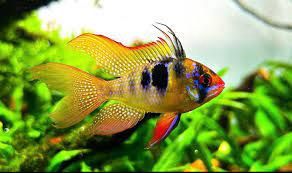German Blue Ramirezi
The German Blue Ram (Mikrogeophagus ramirezi) is a beautiful and popular dwarf cichlid species known for its vibrant blue and yellow coloration. They are peaceful and small enough to be kept in community tanks but require a bit more care than some other freshwater species. Here's a comprehensive care guide for the German Blue Ram:
German Blue Ram Care Guide
1. Tank Setup
-
Tank Size: Although small, German Blue Rams require a minimum tank size of 20 gallons (75 liters). A larger tank offers more stable water conditions and space for swimming.
-
Aquascaping: They enjoy a well-planted tank with lots of hiding spots (e.g., caves, driftwood, and plants). Live plants like Java Fern, Anubias, and Amazon Sword are great choices, as they provide shelter and help maintain water quality.
-
Substrate: A soft substrate like fine gravel or sand is preferred. The Rams like to dig and sift through the substrate, and soft sand is less abrasive to their delicate bodies.
-
Water Temperature: German Blue Rams are tropical fish and prefer warmer water, ideally between 28°C and 30°C (82°F to 86°F). Stable, warm water is crucial for their health.
-
Water pH: They prefer slightly acidic water with a pH range of 6.0 to 7.0, though they can tolerate slightly higher pH levels as long as the water is soft.
-
Filtration: A gentle filter is essential, as they don't like strong currents. A sponge filter or a good hang-on-back filter with adjustable flow can work well. Ensure the filter provides proper oxygenation.
2. Diet
-
Omnivores: German Blue Rams are omnivores and need a varied diet. They should be fed a mix of high-quality flakes or pellets, along with live or frozen foods such as brine shrimp, daphnia, and bloodworms.
-
Vegetation: They also benefit from small amounts of blanched vegetables like zucchini or spinach, but their primary diet should be protein-based.
-
Feeding Frequency: Feed them 2-3 times a day, providing only as much as they can consume in a few minutes to prevent overfeeding and water quality issues.
-
Avoid Overfeeding: These fish are small and can easily become bloated, so careful attention should be given to feeding.
3. Tank Mates
-
Peaceful: German Blue Rams are peaceful, non-aggressive fish, but they can be territorial during breeding. They do best in a community tank with other peaceful species.
-
Good Tankmates: Some compatible tankmates include:
-
Tetras (e.g., Neon Tetras, Cardinal Tetras)
-
Corydoras Catfish
-
Otocinclus Catfish
-
Small Rasboras and Livebearers (e.g., Guppies, Endler's Livebearers)
-
-
Avoid Large or Aggressive Fish: Avoid keeping them with large, aggressive fish like Cichlids (except for similarly peaceful dwarf cichlids) or Barbs, which might nip at their fins or intimidate them.
-
Other Rams: You can keep other German Blue Rams together, but make sure to provide plenty of hiding spots, especially when they’re spawning.
4. Behavior
-
Social and Peaceful: German Blue Rams are peaceful but may display some aggression towards each other during breeding. They are generally calm and often swim around the middle and lower parts of the tank.
-
Territorial During Breeding: While they’re not overly territorial normally, during breeding, they may become more territorial, especially towards other fish that come near their chosen spawning site.
-
Active and Curious: These fish are active and enjoy exploring their environment, searching for food and interacting with each other. They also enjoy having plenty of hiding spots where they can retreat if they feel stressed.
5. Water Quality & Maintenance
-
Water Quality: German Blue Rams are sensitive to poor water conditions, so it's important to maintain stable water parameters. Regular water changes (20-30% per week) are essential for keeping them healthy.
-
Ammonia and Nitrites: Both ammonia and nitrites should always be at 0 ppm. They can tolerate small amounts of nitrates, but keeping it below 20 ppm is ideal.
-
Stable Temperature: These fish prefer stable water temperatures. Avoid fluctuations in water temperature, as this can lead to stress and illness.
-
Use a Heater: A reliable aquarium heater is essential to maintain the warm water temperature they require.
6. Health & Common Issues
-
Stress: Stress is a major cause of illness in German Blue Rams. Keep their environment peaceful, maintain stable water conditions, and avoid keeping them with aggressive or overly active tankmates.
-
Disease: They can be susceptible to common aquarium diseases such as Ich, Fin Rot, and Velvet. Make sure to monitor their behavior and appearance, especially during water changes or after introducing new fish.
-
Skin Health: Their vibrant coloration can fade if they are stressed or if water conditions are poor. Healthy, well-cared-for Rams will maintain their striking blue and yellow hues.
7. Breeding
-
Breeding Setup: German Blue Rams are relatively easy to breed in a well-maintained tank. Create a peaceful, stable environment with plenty of hiding spots and places for them to lay their eggs.
-
Pairing: It’s best to buy a group of juvenile Rams and allow them to pair off naturally. Once a pair is formed, they will typically stay together and will become more territorial during breeding.
-
Spawning: German Blue Rams lay their eggs on flat surfaces, such as rocks or leaves. The female will guard the eggs while the male helps fertilize them.
-
Fry Care: Once the eggs hatch (usually 2-3 days), the fry will swim after 3-4 days. You can feed them infusoria or baby brine shrimp once they’re free-swimming. Provide lots of hiding spots for the fry to help protect them from the adult fish.
8. Lighting and Aquascaping
-
Lighting: Moderate lighting is suitable for German Blue Rams, but avoid overly bright lighting that can stress them or cause algae blooms. Natural daylight or low-to-medium artificial lighting works well.
-
Planted Tank: Live plants are highly recommended, as they provide shelter, oxygenate the water, and help with water quality. Fast-growing plants will also help control any algae.
-
Hiding Spots: Provide plenty of caves, plants, or driftwood to create a safe and comfortable environment for the fish.
Final Thoughts:
The German Blue Ram is a stunning and peaceful cichlid that can thrive in a well-maintained aquarium with appropriate care. They’re a great choice for hobbyists looking for a colorful addition to their tank, as long as you provide stable water parameters, proper diet, and a peaceful tank environment.

